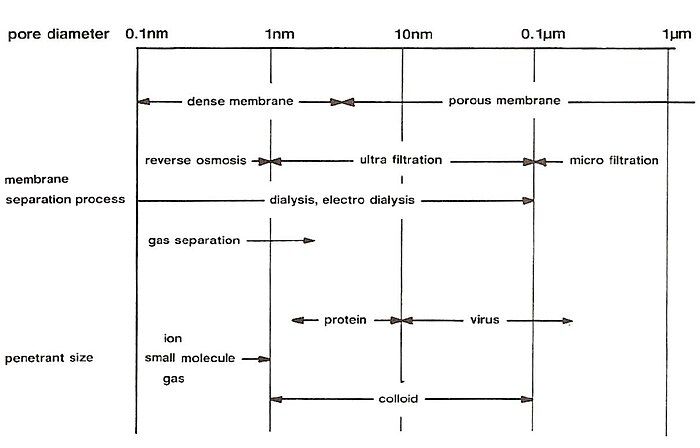User:Peter in s/Baustelle
The membrane technology covers all
Applications


The particular advantage of membrane separation processes is that it operate without heating and thus are energetically usually lower than conventional thermal separation processes (distillation, Sublimation or crystallization). This separation process is purely physical and, thanks to its gentle separation, the use of both fractions (permeate and retentate) is possible. Therefore, the cold separation by membrane processes has been established particularly in the food technology, the biotechnology and pharmacy industrie. Furthermore, with the help of membrane separations realizeable that with thermal processes are not possible. For example, because azeotropics or isomorphics crystallization making a separation by distillation or recrystallization impossible. Depending on the type of membrane, the selective separation of certain individual substances or substance mixtures is possible. Important technical applications include drinking water by reverse osmosis (worldwide approximately 7 million cubic meters annually), filtrations in the food industry, the recovery of organic vapors such as gasoline vapor recovery and the electrolysis for chlorine production. But also in wastewater treatment, the membrane technology is becoming increasingly important. With the help of UF and MF (Ultra-/Mikrofiltration) it is possible to remove particles, colloids and macromolecules, so that wastewater can be disinfected in this way. This is needed if wastewater is discharged into sensitive outfalls, or in swimming lakes.
About half of the market has applications in medicine. As an artificial kidney to remove toxic substances by
Membrane shapes and flow geometries


There are two main flow configurations of membrane processes: cross-flow and dead-end filtrations. In cross-flow filtration the feed flow is
Flat plates are usually constructed as circular thin flat membrane surfaces to be used in dead-end geometry modules. Spiral wounds are constructed from similar flat membranes but in a form of a “pocket” containing two membrane sheets separated by a highly porous support plate.[1] Several such pockets are then wound around a tube to create a tangential flow geometry and to reduce membrane fouling. Hollow fiber modules consist of an assembly of self-supporting fibers with a dense skin separation layers, and more open matrix helping to withstand pressure gradients and maintain structural integrity.[1] The hollow fiber modules can contain up to 10,000 fibers ranging from 200 to 2500 μm in diameter; The main advantage of hollow fiber modules is very large surface area within an enclosed volume, increasing the efficiency of the separation process.

-
Hollow fiber membrane module.
-
Separation of air in oxygen and nitrogen through a membrane
Membrane performance and governing equations
The selection of synthetic membranes for a targeted separation process is usually based on few requirements. Membranes have to provide enough mass transfer area to process large amounts of feed stream. The selected membrane has to have high selectivity (rejection) properties for certain particles; it has to resist fouling and to have high mechanical stability. It also needs to be reproducible and to have low manufacturing costs. The main modeling equation for the dead-end filtration at constant pressure drop is represented by Darcy’s law:[1]
where Vp and Q are the volume of the permeate and its volumetric
where Cf and Cp are the solute concentrations in feed and permeate respectively. Hydraulic permeability is defined as the inverse of resistance and is represented by the equation:[1]
where J is the permeate flux which is the volumetric flow rate per unit of membrane area. The solute sieving coefficient and hydraulic permeability allow the quick assessment of the synthetic membrane performance.
Membrane separation processes
Membrane separation processes have very important role in separation industry. Nevertheless, they were not considered technically important until mid-1970. Membrane separation processes differ based on separation mechanisms and size of the separated particles. The widely used membrane processes include microfiltration, ultrafiltration, nanofiltration, reverse osmosis, electrolysis, dialysis, electrodialysis, gas separation, vapor permeation, pervaporation, membrane distillation, and membrane contactors.[2] All processes except for pervaporation involve no phase change. All processes except (electro)dialysis are pressure driven. Microfltration and ultrafiltration is widely used in food and beverage processing (beer microfiltration, apple juice ultrafiltration), biotechnological applications and pharmaceutical industry (antibiotic production, protein purification), water purification and wastewater treatment, microelectronics industry, and others. Nanofiltration and reverse osmosis membranes are mainly used for water purification purposes. Dense membranes are utilized for gas separations (removal of CO2 from natural gas, separating N2 from air, organic vapor removal from air or nitrogen stream) and sometimes in membrane distillation. The later process helps in separating of azeotropic compositions reducing the costs of distillation processes.

See also
- Artificial membrane
Notes
References
- Osada, Y., Nakagawa, T., Membrane Science and Technology, New York: Marcel Dekker, Inc,1992.
- Zeman, Leos J., Zydney, Andrew L., Microfiltration and Ultrafitration, Principles and Applications., New York: Marcel Dekker, Inc,1996.
- Mulder M., Basic Principles of Membrane Technology, Kluwer Academic Publishers, Netherlands, 1996.
- Jornitz, Maik W., Sterile Filtration, Springer, Germany, 2006
- Van Reis R., Zydney A. Bioprocess membrane technology. J Mem Sci. 297(2007): 16-50.
- Templin T., Johnston D., Singh V., Tumbleson M.E., Belyea R.L. Rausch K.D. Membrane separation of solids from corn processing streams. Biores Tech. 97(2006): 1536-1545.
- Ripperger S., Schulz G. Microporous membranes in biotechnical applications. Bioprocess Eng. 1(1986): 43-49.





